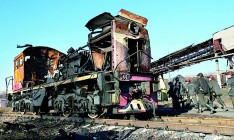Business
chemical industryIn 2014 Ukraine’s chemical industry did not pass all its tests with dignity

This year was perhaps the most difficult for the domestic chemical industry of all the years of Ukraine’s independence. In its modern history the industry has never went through such shocks as the hostilities in the east of the country and the annexation of the Crimea, where the largest exporters of chemical products are located.
Chemical warfare?
Dmytro Firtash, who has been acquiring major chemical assets since 2010, has suffered more than other owners of chemical enterprises in Ukraine. In May the militants occupied Horlivka and Severodonetsk, home to the most powerful exporters of ammonia and carbamide owned by Firtash – Stirol concern and the Severodonetsk association Azot. As a result, the businessman was forced to suspend operations of those enterprises for security reasons. Thus, the part of Firtash’ nitrogen empire responsible for export-oriented products was immobilized. Azot in Cherkasy and Rivneazot, remaining in his possession in the unoccupied territories, are strategically focused on domestic customers. They cannot provide Firtash with such export volumes of carbamide and ammonia as Stirol and Azot in Severodonetsk.
The role of these enterprises for the country is eloquently demonstrated by statistics of the decline of hard currency earnings over the last 10 months. While in January–October 2013 exports of fertilizers amounted to approximately US $1 bn, in the same period this year – the amount was only US $554 mn. The plants blocked in the Donbas created a shortage of fertilizers on the domestic market, which by the end of this year experts have estimated as half a million tons, or UAH 2.5 billion in monetary terms.
Crimean “Titanic”
Firtash himself has never concealed the fact that he was interested in building up a titanium empire in Ukraine more than in other business spheres. Here the ambitions of the businessman and the Ukrainian economy have coincided to a certain extent, as the integration of assets in the industry promised the country strengthening of its positions on the global market.
For example, on the market of titanium sponge Ukraine planned to increase its presence from 5% to 14%. To do so, Tolexis Trading, which is part of Firtash’ Group DF, joined the management of the Zaporizhzhia Titanium-Magnesium Works (ZTMW) in 2013 and gained control of 49% of the plant’s property in exchange for future investments.
In the foreseeable future it was expected that the ZTMW would eventually increase its capacity for the production of titanium sponge and cast slabs by 4 times – up to 40,000 t. This opened a new metallurgic business segment for the entrepreneur.
And the titanium segment, in which it has been present for more than 10 years – the release of titanium dioxide – was split by the annexation of Crimea. When in the spring of 2014 Russia claimed Crimea to be its territory and appointed its deputies in the peninsula, the latter began threatening Firtash with “re-privatization” of his Crimea Titan and the Crimea Soda Plant. As a result, in summer the businessman re-registered the Crimean Soda Plant, thus turning it into a Russian enterprise.
This process was more difficult with the Crimean Titan plant, which produces the aforementioned dioxide (also known as titanium pigment or titanium dioxide). This is one of the most valuable facilities for implementation of strategic plans for Firtash’ Group DF. Up until now, his entire Crimean chemical complex was supplied with raw materials from mainland Ukraine, in particular, ilmenite concentrate from the state-owned Irshansk MPP, which by September 9, 2014 has been under lease of Crimea Titan.
In an attempt to satisfy the self-proclaimed premier of Crimea Sergei Aksyonov, Group DF leased the industrial complex Crimea Titan to Moscow Titanium Investments LLC (established by one Firtash’ structures) this September. And the legal address of Crimea Titan was moved to Ukraine by registering a legal entity at 2 Mechnikova St. in the Parus business center in Kyiv, which is also owned by the company. So, the company won the deal to be able to freely supply ilmenite raw materials from continental Ukraine and satisfied the Ukrainian government by creating the illusion that the Crimean company still belongs to Ukraine.
Stop the MPP
As soon as the hype about the registration of Crimea Titan abated in Crimea and Russia, the company’s lease of the richest deposits of ilmenite ore in Ukraine – the Volnohorsk MMC and the Irshansk MPP – expired. And in the fall Firtash’ companies started fighting for the objects, trying to prevent the inventory of their property and transfer them to state control.
In order to defeat Firtash, Yatsenyuk’s government involved the United Mining and Chemical Company (UMCC). According to the decision of the Cabinet, in September it was conveyed the property of the Volnohorsk MMC and the Irshansk MPP for maintenance and management. In October it received full control over the enterprise. Firtash failed at his attempt to prolong the presence of Crimea Titan at the MPPs through the courts as they sided with the UMCC in accordance with the law.
Having lost the mining companies, Firtash can no longer implement his ambitious plan to increase production of titanium dioxide at Crimea Titan and Sumykhimprom (controlled by management loyal to the businessman) using controlled ilmenite assets of the Mezhyrichenskiy MPP and Valky-Ilmenite.
Now, these plants produce a total of 150,000 t of products per year. Firtash was going to increase the amount to 400,000 t. Such volumes would allow Ukraine to increase its share on the global market from the current rate of less than 1% to just over 2%.
For Firtash the profitability of the business after losing the MPPs will significantly fall due to the the lack of access to cheap raw materials. He also lost the opportunity to diversify supplies, which Group DF has always enjoyed. During the crash of prices of the pigment the company increased exports of ilmenite concentrate obtained at MPPs, thereby compensating for the loss of the market of its finished product.
Factors of support
Despite this, not all the repercussions of the political and economic crisis had a negative impact on the industry. For example, the collapse of the national currency has allowed exporting chemical plants to increase hryvnia revenues and cut their losses in half. DniproAZOT, which belongs to the Privat Group, managed to increase its profits tenfold over 9 months of 2014: up to UAH 13.6 mn versus UAH 1.3 mn over the same period in 2013. The OPP reduced its losses over this period by 2.5 times to UAH 243.4 mn. And even the state-owned Sumykhimprom, still under control of Firtash’ managers, reduced its losses by 2.3 times to UAH 59 mn.
The collapse of the hryvnia has also helped maintain import of fertilizers: fearing losses resulting from the fluctuations in the exchange rate traders delayed the delivery of complex, phosphate and nitrogen fertilizers for a few months, while domestic prices have significantly outpaced export quotations. This contributed to the improvement of the financial results of domestic chemical enterprises.
“Protection” of domestic market
Import was also constrained by the fact that in July 2014 the Ministry of Economic Development and Trade doubled anti-dumping duties on imported Russian ammonium nitrate produced by the Akron and Dorogobuzh companies (up 20.51%). A duty of 36.03% was imposed on Russian EuroChem and other suppliers. At the same time, Russian companies were given no chance to even utter a word against this decision – the procedure of establishing barriers was quick and none of the arguments of the Russian side were taken into account. The duties were introduced in less than a month upon warning of Russian chemical plants.
For consumers of fertilizers such protectionist measures were disastrous. This immediately led to the situation where Russian producers stopped importing ammonium nitrate in Ukraine in the offseason. Against the background of the shutdown of Firtash’ plants in the Donbas and the associated deficit of ammonium nitrate, the cost of fertilizers in Ukraine began to rise, breaking historical records. As a result, in December Ostchem plants stopped direct supply of ammonium nitrate to their clients and its cost for traders was set at the level of UAH 6,200–6,300 per 1 ton. A year ago, ammonium nitrate cost UAH 2,770/t.
Loss of markets
This year Ukrainian chemical plants were forced to reduce exports not only due to the down time at a number of enterprises in the industry, but also because of the suppression of their products on a number of foreign markets. In particular, over the past year the industry has virtually ceased to supply carbamide to India – one of its largest foreign markets. From there Ukrainian producers were ousted by Chinese manufacturers, which have been contributing to the collapse of prices on Indian tenders for the second consecutive year.
In December it became known that Ukraine lost the Pakistan market, which also buys carbamide on tenders, because buyers chose to purchase the same product from Iran.
Ukrainian chemical plants will be unable to regain these markets over the next few years, because winning a tender against China and Iran would mean they would have to offer prices of carbamide that are almost twice lower than its production cost. Such victims are irrelevant as long as there are other markets, such as Turkey, North Africa, Latin America and the EU.
But the trouble is that in two–three years the EU market, as well as the market in Latin America, could be lost as well. In particular, the U.S. is preparing for expansion into Latin America in 2016–2018 with the introduction of its own nitrogen capacities operating on shale gas that will not leave Ukrainian producers any chance of competing in the region. Thus, Turkey and the EU are the most lucrative markets that Ukrainian chemical plants should be competing on over the next couple of years.
Competition for assets
Firtash’ positions in Ukraine, weakened by foreign and domestic policy, are not cooling down his ardor. Through his companies Firtash continues to fight for control of the state-run Sumykhimprom and the Odesa Port Plant, which the government wants to put up for privatization next year. At the Sumy plant Firtash is delaying the reorganization procedure and is preparing for the plant’s shutdown by buying out debts from its lenders in order acquire the company one way or another. For several months the Prosecutor General’s Office has been unsuccessfully trying to achieve the dismissal of Firtash’ manager, Chairman of the Board of Sumykhimprom Ihor Lazakovych. The latter does not allow other creditors to receive their entitlements in the amount of more than UAH 800 mn.
Privatization of the OPP was virtually blocked by the lawsuit filed Firtash’ gas company RGC Trading. Its management is demanding that the enterprise pay for natural gas worth UAH 1.3 bn delivered to it in the first half of 2014. The OPP is requesting the court to allow it to make payments in installments, which is delaying settlement of accounts with suppliers and reducing the attractiveness of the facility that Yatsenyuk’s Cabinet wants to sell at a profit in 2015.
Thus, major chemical enterprises will enter next year with the prospect of further redistribution of their assets, both public and private. Premier Yatsenyuk is undermining their positions with his inconsistent decisions on the gas market. At first he prohibits Firtash’ plants to use previously purchased and stored gas, then he narrows the possibility of reverse supplies to the OPP, thus eventually forcing all chemical plants to enter into disadvantageous agreements with Naftogaz.











 of the agreement of syndication with Financial Times Limited are strictly prohibited. Use of materials which refers to France-Presse, Reuters, Interfax-Ukraine, Ukrainian News, UNIAN agencies is strictly prohibited. Materials marked
of the agreement of syndication with Financial Times Limited are strictly prohibited. Use of materials which refers to France-Presse, Reuters, Interfax-Ukraine, Ukrainian News, UNIAN agencies is strictly prohibited. Materials marked  are published as advertisements.
are published as advertisements.